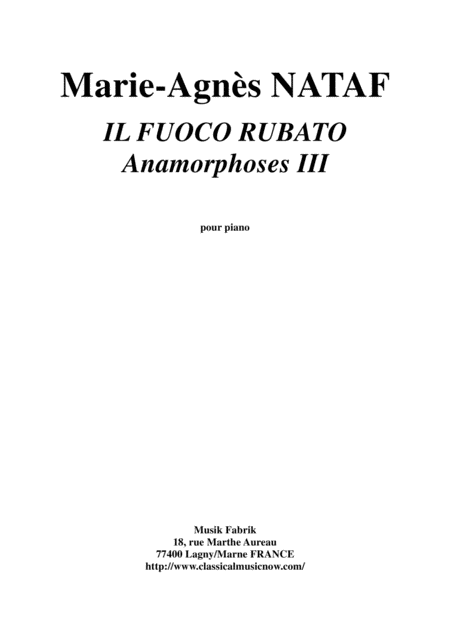Piano Solo - Level 3 - Digital Download SKU: A0.533330 Composed by Marie-Agnès Nataf. Concert,Contemporary. Score. 7 pages. Musik Fabrik Music Publishing #2344341. Published by Musik Fabrik Music Publishing (A0.533330). Il fuoco rubato is one of the 3 pieces for piano solo Anamorphoses whose titles areBartoquade I, Bartoquade II b and Il fuoco rubato. These pieces can be linked together as awhole, in that order. The duration is of 5 minutes. They can also be played separately, orgrouped by two (Bartoquades I et II b, duration 3’). The same approach governs the writing ofthese compositions : taking model on works of the repertoire and transforming them as muchas possible while keeping a lot of important parameters.There are many cautionary accidentals. They are not enclosed in brackets to avoidoverloading writing. They are not systematically mentionned. In case of doubt, one willconsider the logic of the composition. When useful, one can distribute differently notesbetween the 2 hands on the condition of respecting the balance between voices. The sign *[on measure 80 means chromatic cluster (F-F#-G). Marie-Agnès NATAF was born on March 2, 1952 at Issy-les-Moulineaux, in the suburbs of Paris, Before deciding to devote herself completely to music, she began by studying both mathematics and musics at the same time. She had a varied base in her musical training, which allowed her to understand the teaching of her main teacher Narcis BONET. She studied the piano, chamber music, musical analysis, harmony and also to a lesser degree the flute, counterpoint and conducting. As a pianist, she received a First Prize in Piano and in Chamber Music at the Orsay Conservatory, the Gold Medla at the National Music School of Cahcan and the Artist Diploma at the Ecole Normale de Musique de Paris – in the class of Germaine MOUNIER. For composition, she studied with Narcis BONET (who later invited her to the Conservatoire Américain of Fontainebleau as accompanist and teacher of French Diction), Yoshihisa TAÏRA, and Edith CANAT de CHIZY. Having taught for a time at the Ecole Normale de Musique de Paris, she is currently professor of piano at the Conservatoire Erik Satie of Villebon-sur-Yvette, Marie-Agnès Nataf has a double career of performer and composer. In both areas, she is especially attracted to chamber music, for the rich musical and human exchanges that this type of music permits. She has written her works Trois mélodies sur des poèmes de Marie-Isabelle SOLANO, Révolte sans paroles and Elan brisé for her colleagues the mezzo-soprano Nicole PARAMYTHIOTTI and the flutiste Isabelle MARCHAL with whom he has given concerts for many years. As a performer, she has premiered works by composers such as Gian-Paolo CHITI, Gloria COATES, Jean-Marie MACHADO, Yoshifumi UMEZAWA, Miao Wen WANG, without speaking of her own compositions. She also tries to discover high quality works of music which are rarely performed, especially works by women composers such as Thérèse BRENET, Dianne GOOLKASIAN-RAHBEE, Ruth LOMON. Her principal works are Trois mélodies sur des poèmes de Marie-Isabelle SOLANO, for mezzo-soprano and piano, 8'30, 1981-83-86. Bartoquade I - Anamorphoses I, 1', et Bartoquade II b - Anamorphoses II, 2', for piano, 1990 revised in 2012. Il fuoco rubato - Anamorphoses III for piano, 2', 1991 revised in 2012. Révolte sans paroles for mezzo-soprano, flute and piano, 16'30, 2000. and Elan brisé and flute and piano, 6'30, 2005. In 2001, on the ocassion of the premier of Révolte sans paroles at the Centre Culturel Jacques Brel of of Villebon-sur-Yvette, she was invited to give a conference on her works at the Conservatoire Erik Satie. In April 2002, her songs were selected by the ensemble North /South Consonance directed by Max LIFCHITZ in a competition. In 2012, the Bartoquades were chosen to be on the list of works proposed by the FFEM for their examination list for intermediate pianists. On the su.
